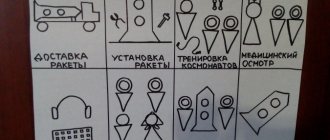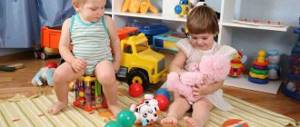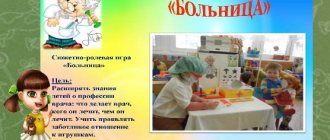Summary of the role-playing game "Children's Cafe"
This role-playing game is designed for children of senior preschool age. It can serve as both a preparatory and final stage of educational activities on the topic “Professions”.
Tasks:
- expand children's knowledge about the work of adults (administrator, cook, waiter, bartender, musician, security guard, photographer, policeman);
- establish rules of conduct in public places;
- encourage children to do basic game planning and independently select attributes;
- develop the ability to conduct dialogue with playing partners;
- continue to develop the ability to perform game actions in accordance with the game rules and the role taken, negotiate, discuss the actions of all players, follow the rules of the game;
- cultivate friendly relationships in the children's team.
Material and equipment : Badges: “cafe administrator”, “waiter”, “bartender”; uniform for waiter, bartender, security guard, cooks; tablecloths for tables; distributions; folders-menus with pictures; “kitchen” module; cash register with receipts; money; dummies of fruits and vegetables, products made from salted dough of cakes, buns, pies, fruits, berries, ice cream; children's tableware and kitchenware; paper and textile napkins; small vases with flowers; wallets; bags; pens and notepads for writing down orders; musical instruments; camera; recording of a dog barking, children's songs.
Playing roles: administrator, cook, bartender, waiter, security guard, photographer, policeman, musicians, visitors.
Number of children: 10-15 people.
Organization of activities
Educator : Guys, today in my mailbox I found an advertisement about the opening of a children's cafe called “Kolobok”. Look how bright and interesting the advertisement is.
Educator : Guys, which of you was in the cafe? (Children's answers).
Educator : Why do we go to the cafe? (Children's answers).
Educator : Who works in the cafe? (Children's answers).
Educator : Do you want to visit the children's cafe "Kolobok"? (Children's answers).
Educator : I propose to open a children's cafe in our group. Guys, do you agree? (Children's answers).
Educator : What do you think is necessary to open a cafe? (Children's answers).
(The teacher, together with the children, participates in creating the interior of the cafe in the group, giving instructions if necessary).
Educator : Our Kolobok cafe is ready. I propose to choose two cooks, a waiter, a bartender, two musicians, a security guard, a photographer, cafe visitors, and I will be the administrator.
(Children select costume attributes in accordance with the role and take their places).
Game development:
(A cheerful melody sounds).
Cooks in the kitchen prepare preparations; the bartender polishes glasses, prepares napkins; the waiter sets the table; musicians tune instruments, check the microphone; a security guard stands at the entrance.
The administrator greets the guests and invites them to come in and sit at the tables (guests with a dog are asked to tie it at the entrance).
The waiter presents the menu, offers to place an order, and gives advice on choosing an order.
Guests study the menu, ask questions, place orders.
Waiters take orders at each table and take them to the cook and bartender.
The photographer approaches the guests and asks permission to conduct a photo shoot.
The musicians begin the concert.
While visitors are waiting for their order, the administrator invites everyone to dance.
The waiter brings food and drinks and places them on the table.
Guests of the cafe try dishes and talk.
The photographer brings finished photographs.
Dogs barking can be heard from the street. The dog's owner comes out to check on her and sees that she is missing.
A policeman is called by phone (the photographer takes this role).
A policeman is looking for a dog (from the photo).
The guests continue to relax and talk.
The policeman brings the found dog, the guests thank him.
The waiters bring the bill, the visitors pay and thank the cafe staff.
The administrator sees off the guests and invites them to come more often.
Educator : Did you like the game? What did you like best? (Children's answers).
Educator : What professions have we reincarnated into today? (Children's answers).
Educator : Do you think everyone coped with their roles? (Children's answers).
Educator : Who did you like the most? (Children's answers).
Educator : Did all the participants follow the rules? (Children's answers).
Educator : What roles can be added to our game? (Children's answers).
Summary of the plot-role-playing game in the preparatory group
Summary of the role-playing game “Journey to the Mysterious Island” in the preparatory group
Author. Makarova Nadezhda Leonidovna, teacher of the MDOU combined type kindergarten No. 30 Kipen, Leningrad region. Description. I offer a summary of the role-playing game “Journey to the Mysterious Island” for children in the preparatory group. This work will be of interest to teachers of preschool institutions who work with children of this age category. The relevance of conducting role-playing games. Role-playing games allow you to develop children's creative abilities and their imagination. In the game, children learn to get used to the image of a particular character and play a certain role. They are of great importance in the social adaptation of the child and the realization of his potential in the future. In the role-playing game, the child’s personality, his intelligence, will, imagination and sociability are successfully developed, but most importantly, the role-playing game generates the desire for self-realization and self-expression. Target. To develop in children the ability to combine various thematic plots into a single game plot; establish and regulate contacts in a joint game. Tasks. 1. Expand the range of children's games, teach them to play together (discuss the plot, come up with new roles and game actions), help create a game environment taking into account the theme of the game and an imaginary situation, teach them to name their role, verbally determine the events depicted, the location of the players (here is the sea , this is a ship, it is sailing to a mysterious island, etc.). 2. Reinforce in children the sequence of days of the week, the number and order of counting, the names of geometric shapes, measuring objects using a conventional measure, and orientation in space. 3. Activate children's vocabulary: cabin, navigator, boatswain, porthole, cook, travel agency, courier, cruise. 4.Develop creative thinking, imagination, and fantasy in children. 5. Cultivate friendly relationships and a sense of teamwork in children. Preliminary work. Examination of photographs, illustrations, pictures depicting various ships. Construction of ships from various building materials and paper. Reading “Native Man” by V. Korzhikov, “Shark” by L. N. Tolstoy. Making attributes for the game. Watching the cartoon "Boniface's Vacation." Conversation after watching the cartoon. Writing stories on the topic: “What if I went on a trip.” Game attributes. Modules for building a ship, seven multi-colored (according to the colors of the rainbow) flags, caps, binoculars, an anchor, small toys from Kinder surprises, a conventional measure - braid, napkins, wallets, money, tickets, a computer, bananas, a cutting board.
Progress of the game.
Educator.
Children, let's play with you.
What game do you want to play? (Children's answers). Educator.
Okay, we're going on a sea cruise!
What will we sail on? (Children offer different options - choose a ship). Educator.
Guys, what day of the week do you think is best to travel?
Why? What is the day of the week called today? (Children's answers). Let's not delay our voyage! Let's go traveling today! Educator.
Let's think about where we're going? (Children's answers. I offer the children seven multi-colored (according to the colors of the rainbow) flags, on one side of each flag a letter is written.) Guys, if you arrange the flags by color in the same order as a rainbow, then you will find out where we will go on the cruise. (Children complete the task and read the word “islands”). Yes, to the islands!
Together with the children, we decide what we need to prepare for the trip and assign roles. We choose an agent to work in a travel agency, a courier to purchase vouchers, a supermarket seller, a supply manager to purchase the necessary goods for the cruise (a set of small toys, wet wipes, four knives). The rest of the children are ship designers (we build the ship from modules). When everything is ready for the trip (tickets have been purchased, goods have been purchased, and most importantly, the ship has been built), the children choose a captain, a navigator, and a cook. The rest of the children will be sailors. Boarding of the ship is announced. The captain checks the tickets, it turns out that the tickets were bought from a travel agency to the “Mysterious Island”. Everyone takes their places on the ship. The captain gives the command to the navigator. The ship departs from the pier (a recording of the sound of the sea and a ship signal sounds). During the journey, children play with their tickets. The tickets are unusual, with tasks. On one side of the ticket you need to count the number of objects, and on the reverse side you need to find the differences in the picture depicting two ships.
So the ship approaches its destination unnoticed, but a problematic situation arises.
There is no ship pier on this island. Educator.
Children, how can you get to the island?
(Children's answers). The captain suggests getting to land using a life preserver. Children imitate swimming with a lifebuoy to the song “Chunga-Changa” by V. Ya. Shainsky and land on the island. On the island we listen to birdsong (a recording of bird voices sounds). Next, the children try to imagine what can grow here, how beautiful it is here. Educator.
Children, it is very hot on the island, you can take off your shoes and walk barefoot on the sand.
(At this time, small toys from Kinder surprises that the children wanted to play with accidentally fell apart.) How can you collect the toys? (Children's answers). Yes, of course, now you and I will turn into monkeys and collect toys with our toes. (Children collect toys with their toes and put them in a basin.) Educator.
Who do you think lives on the island? (Children's answers). We put together a cut-out picture and find out what kind of funny people live here.
Educator.
Children, how can you imagine what kind of home they might have? What might their house be called? (Children's answers). We will now come up with a home for them using these pictures. (The game “Wonderful Things” (TRIZ) is being played. This game can be found in the book “Amazing Stories” by L. E. Belousova. The house is green, made of rubber, four-story, moves on chicken legs, a guitar is always playing in it, the smell of strawberries in the house. We discuss with the children whether it is comfortable to live in such a house. The game “Good - Bad” (TRIZ) is played.)
Educator.
Children, if this island is mysterious, there must be treasures here?
(The game is played: “Find the treasure.” Three children are blindfolded. According to the specified plan, they look for treasures. The plan is voiced by the captain. The children quickly find the treasure, but they cannot open it without guessing the following spell (a recording from a tape recorder sounds): “There are two objects - one of them grows here on the island, the other is in your group and in the music room. Both of these objects begin with one sound and end with a sound, but another. Each word has five sounds. Children guess the word "banana" and the word “tambourine.” A treasure opens (a beautiful antique chest prepared in advance), and there are bananas.) Educator.
Guys, we are on an unusual island, it’s so mysterious, and it’s hot here. Maybe we can turn these bananas into ice cream? (The children happily agree.) Then let's wash our hands first. (A finger game is played. “Wash your big finger, wash your index finger, wash your middle finger, ring finger and small little little finger.” Children wash their fingers using wet wipes. The cook distributes bananas. The children are faced with a problematic situation - there are not enough bananas for everyone. What to do? Children using a conventional measure (braid), divide the bananas in half, then cut, peel, insert an ice cream stick on one side of the banana and roll the banana in cocoa.You get ice cream and everyone treats themselves.
Educator.
Guys, let's take a look at the magic chest where the bananas were. (The children look into the chest, it turns out to have a second bottom. There the children find souvenirs from the inhabitants of the island - jewelry with a shell.) The journey comes to an end. We have to go back to kindergarten. Children close their eyes and say the magic words: “One, two, three, four, five - we are in kindergarten again.” And they end up in a group. They look at their jewelry and plan to go to the mysterious island again, so that next time they can get acquainted with the marine inhabitants of the island.
We recommend watching:
Summary of the plot-role-playing game for children 3-4 years old Summary of open intellectual and physical education leisure in the preparatory group Synopsis of the plot-role-playing game “Zoo” in the middle group Game leisure based on Pushkin’s fairy tales in the preparatory group of the kindergarten
Similar articles:
Summary of a lesson in the preparatory group on the topic: Spring
Playful musical entertainment for children of the preparatory group in kindergarten. Scenario
Spring leisure in the preparatory group. Semik - Russian rite of flowering
Fun in the preparatory group. Russian customs
Fun game for children in the preparatory group of kindergarten







